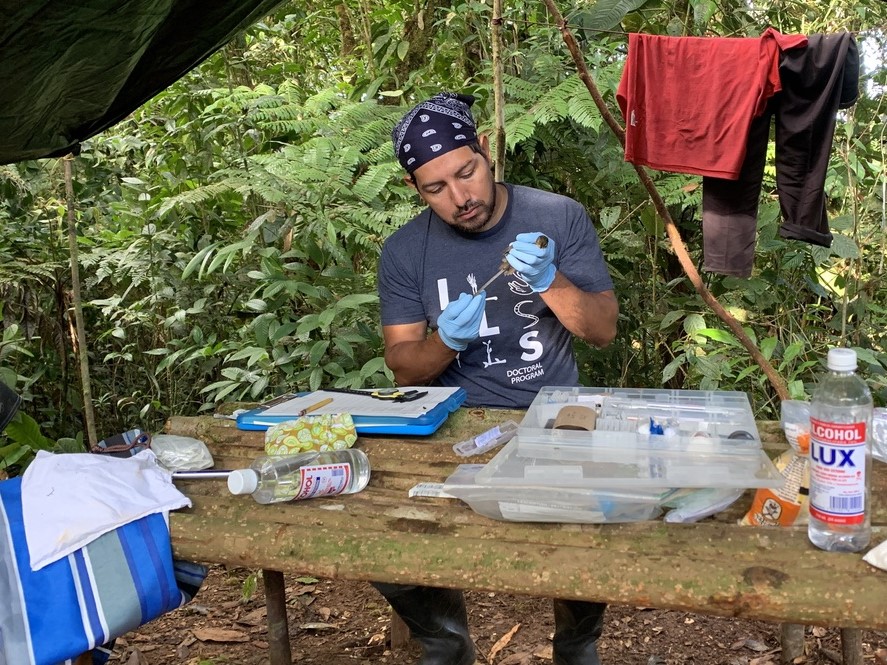CILSE Ph.D. student Jorge Garzon travels deep into the rainforest for his research
Nov. 30, 2023

Jorge Garzon ends his four-day journey – mostly on foot – as he reaches Tacarcuna, Panama and sets up camp. Tacarcuna, an isolated area deep in Darien National Park, shares a border with northwest Colombia and is the bridge between North and South America. Travel is treacherous, and fraught with danger. But that doesn’t deter Garzon because this remote region is where his research lives.
Garzon, a Ph.D. student in the Center for Integrative Life Science Education, studies birds from the Darien highland and the role they play in conservation. The geographic landscape is void of any human intervention. Garzon says this is a perfect environment for his research. “This pristine area will provide important information,” he says. “My research is on the population genetic structure that is influenced by the landscape, and the gene flow between avian populations that inhabit the different mountain ranges in Darien.”
Tacarcuna hasn’t been studied since the 1960s because of how long it takes to get there, but that is what makes it such an attractive place to conduct his research. “There are three different areas of interest for my research on endemic bird species which includes ecology, morphology and population genetics,” states Garzon. “This area is so important for endemic birds in the area, as these species are so important in the process of evolution. The endemic birds were discovered 100 years ago and because of logistics, have hardly been studied.”
The first day consisted of a six-hour ride by car, one hour in a canoe and another two hours by car. Daybreak brought to him an indigenous people’s village, where he was able to hire six members from the community who knew the area well. They acted as guides, and since traveling by canoes and by foot were the only way forward, helped carry the research gear, camping supplies, and food until they reached their destination. A herpetologist and a botanist also joined the trip looking for novelties in the area.
The dangers of the forest are not just the wild native species and rough terrain; because of the vastness of the area, traffickers used the land as a corridor. Local police in various villages were wary of outside visitors, so Garzon had to bring an explanation on Adopt a Rainforest Panama (ADOPTA) letterhead to explain why he was in the area.
Even with all potential obstacles in the way, “it was worth it,” say Garzon. “Through it all you know what could happen, but I really focused on enjoying the hiking and being surrounded by nature.”
A native of Panama, Garzon graduated from the Universidad de Panamá, Panama in 2014 with a degree in Biology. There was not a lot of faculty motivation for students to continue studies beyond their undergraduate degree, but Garzon realized he wanted to explore his options. That led him to The Gorgas Memorial Institute for Health Studies (GMI) in Panama, where his research focused on tropical diseases such as yellow fever in monkeys and hantavirus in rodents.
His work earned him a three-month internship in 2016 at the Sam Noble Museum at Oklahoma’s Museum of Natural History, where Garzon collected bird samples.
Once he completed his internship, he returned to Panama, where a conversation in early 2017 with Catherine Viverette, Ph.D., assistant professor in the Center for Environmental Studies, led him to VCU. Viverette and Ed Crawford, Ph.D., deputy director of VCU Rice Rivers Center and assistant professor in the Center for Environmental Studies, led a group of VCU students to Panama. They arrived in January to conduct research in the Prothonotary Warbler’s winter habitat, after tracking their migration from locations near Rice Rivers Center. Garzon was a volunteer with ADOPTA and was asked to lead the VCU group and assist with the research conducted in the Prothonotary Warbler’s wintering habitat, the mangrove forests lining the Pacific and Caribbean coasts of Panama. Once field work was completed, Garzon led the students and faculty on a much anticipated expedition to Cerro Chucantí, an isolated cloud forest preserve protected and managed by ADOPTA.
During their time together, Viverette suggested Garzon apply to the master’s program at VCU, but to do that, he would need to first apply for scholarships. While looking into how obtain this funding, he learned it was easier to obtain a scholarship from the Panamanian government if he pursued a Ph.D. In 2018 while Jorge was working as an assistant in the virology lab of the GIM he decided that was time to applied for a scholarship with SENACYT Panama, which he successfully earned.
In the fall of 2019, Garzon became a Ph.D. student with Viverette and Rodney Dyer, Ph.D., director of the Center for Environmental Studies, as his advisors. His area of research is the speciation and endemism of birds. Garzon returned to Panama during the summers to continue his research in Tacarcuma, but in 2020 the pandemic brought travel to a halt and funding dried up. It was two years later than he was able to apply for new scholarships to help him return to the forest.
2022 brought Garzon to Rice Rivers Center for its Summers Scholars program, where he worked and earned additional experience banding birds with Viverette and Lesley Bulluck, Ph.D., associate professor in the Center for Environmental Studies.
Garzon is scheduled to defend his thesis in 2024, and plans to return to Panama to pursue his postdoctoral. “I want to continue with my research,” state Garzon. “I also have my sights on becoming a professor and to help undergraduate students find their motivation to take their next step toward graduate studies.”
Some photo of Garzon's recent research trip to Panama can be found at the Rice Rivers Center Facebook page.